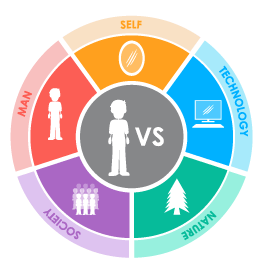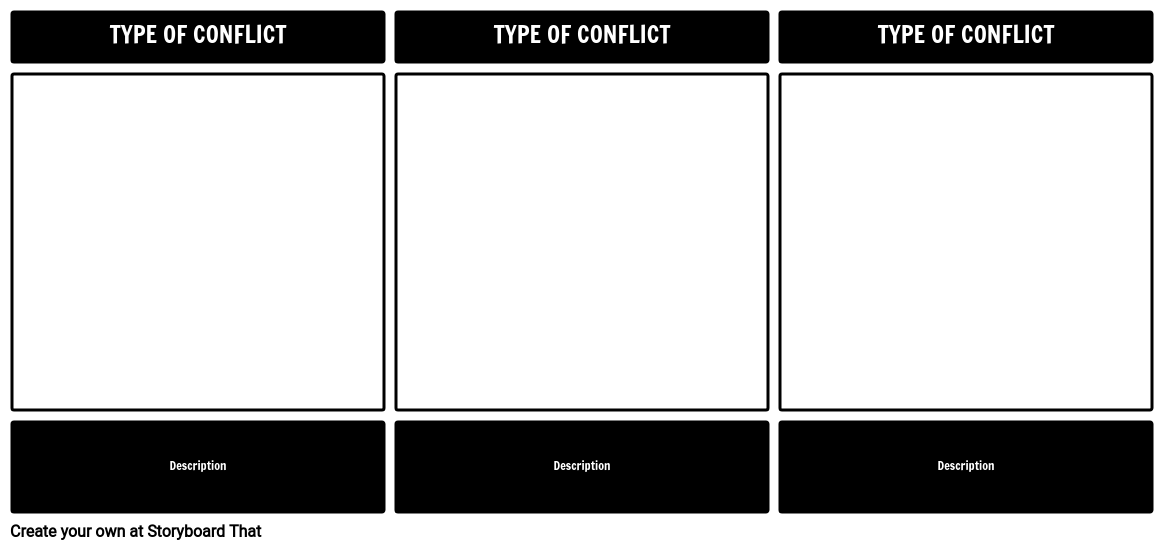Lesson Plan Overview
Storyboarding is an excellent way to focus on types of literary conflicts.
Having students create storyboards that show the cause and effect of different types of conflicts strengthens analytical thinking about literary concepts. Have your students choose an example of each literary conflict and depict them using the storyboard creator. In the storyboard, an example of each conflict should be visually represented, along with an explanation of the scene, and how it fits the particular category of conflict.
Examples of Literary Conflict in Catherine, Called Birdy
MAN vs. MAN
Catherine has conflicts with a number of people around her on a daily basis. She consistently quarrels with her brother Robert when he is around. She insults him, and he generally responds by pinching her.
MAN vs. SOCIETY
Catherine frequently rebels against the expectations of her society. Catherine hates the limits that Medieval society placed on women and noblewomen in particular. Much of her unhappiness comes from the ladylike chores she must complete and the arranged marriage she is expected to accept.
MAN vs. NATURE
After Catherine's mother gives birth to a baby girl, she faces complications and nearly dies. Although Mother is the one facing death at the hands of nature, Catherine, too, is in conflict with nature since the illness also impacts her life negatively.
MAN vs. SELF
Catherine struggles to develop a sense of identity. She does not feel like she fits in with the life that is expected of her, so she tries to imagine alternative options. None of these seem to suit her, however, and she spends months feeling miserable and unsettled.
Template and Class Instructions
(These instructions are completely customizable. After clicking "Copy Activity", update the instructions on the Edit Tab of the assignment.)
Student Instructions
Create a storyboard that shows at least three forms of literary conflict in Catherine, Called Birdy.
- Identify conflicts in Catherine, Called Birdy.
- Categorize each conflict as Character vs. Character, Character vs. Self, Character vs. Society, Character vs. Nature, or Character vs. Technology.
- Illustrate conflicts in the cells, using characters from the story.
- Write a short description of the conflict below the cell.
Lesson Plan Reference
Student Rubric
(You can also create your own on Quick Rubric.)
| Proficient | Emerging | Beginning | |
|---|---|---|---|
| Conflict Identification | Student identifies conflicts as directed and labels them accurately in their correct categories. | Student misidentifies one conflict or includes it in an incorrect category. | Student misidentifies two or more conflicts or includes them in incorrect categories. |
| Conflict Explanation | The storyboard text describes the specific example depicted, not just a general problem. The text clearly explains how the example reflects its particular type of conflict. | The storyboard text describes the specific example depicted, but may lack clarity. Text may fail to fully explain how the example reflects its particular type of conflict. | Storyboard is missing text or contains only partial and/or inaccurate information. |
| Storyboard Image and Effort | Student clearly shows effort to convey the setting, characters and specific scene of the book. The scene is clearly identifiable based on the graphic depiction. | Student attempts to convey the setting, characters, and specific scene through use of graphics, but the depiction may be confusing, disordered, or lack some detail. | Student does not clearly convey the setting, characters, and scene. |
| Spelling and Grammar | Student uses exemplary spelling and grammar. There are no errors. | Student makes one or two minor errors in spelling and grammar. | Student makes multiple errors in spelling and grammar. |
Lesson Plan Overview
Storyboarding is an excellent way to focus on types of literary conflicts.
Having students create storyboards that show the cause and effect of different types of conflicts strengthens analytical thinking about literary concepts. Have your students choose an example of each literary conflict and depict them using the storyboard creator. In the storyboard, an example of each conflict should be visually represented, along with an explanation of the scene, and how it fits the particular category of conflict.
Examples of Literary Conflict in Catherine, Called Birdy
MAN vs. MAN
Catherine has conflicts with a number of people around her on a daily basis. She consistently quarrels with her brother Robert when he is around. She insults him, and he generally responds by pinching her.
MAN vs. SOCIETY
Catherine frequently rebels against the expectations of her society. Catherine hates the limits that Medieval society placed on women and noblewomen in particular. Much of her unhappiness comes from the ladylike chores she must complete and the arranged marriage she is expected to accept.
MAN vs. NATURE
After Catherine's mother gives birth to a baby girl, she faces complications and nearly dies. Although Mother is the one facing death at the hands of nature, Catherine, too, is in conflict with nature since the illness also impacts her life negatively.
MAN vs. SELF
Catherine struggles to develop a sense of identity. She does not feel like she fits in with the life that is expected of her, so she tries to imagine alternative options. None of these seem to suit her, however, and she spends months feeling miserable and unsettled.
Template and Class Instructions
(These instructions are completely customizable. After clicking "Copy Activity", update the instructions on the Edit Tab of the assignment.)
Student Instructions
Create a storyboard that shows at least three forms of literary conflict in Catherine, Called Birdy.
- Identify conflicts in Catherine, Called Birdy.
- Categorize each conflict as Character vs. Character, Character vs. Self, Character vs. Society, Character vs. Nature, or Character vs. Technology.
- Illustrate conflicts in the cells, using characters from the story.
- Write a short description of the conflict below the cell.
Lesson Plan Reference
Student Rubric
(You can also create your own on Quick Rubric.)
| Proficient | Emerging | Beginning | |
|---|---|---|---|
| Conflict Identification | Student identifies conflicts as directed and labels them accurately in their correct categories. | Student misidentifies one conflict or includes it in an incorrect category. | Student misidentifies two or more conflicts or includes them in incorrect categories. |
| Conflict Explanation | The storyboard text describes the specific example depicted, not just a general problem. The text clearly explains how the example reflects its particular type of conflict. | The storyboard text describes the specific example depicted, but may lack clarity. Text may fail to fully explain how the example reflects its particular type of conflict. | Storyboard is missing text or contains only partial and/or inaccurate information. |
| Storyboard Image and Effort | Student clearly shows effort to convey the setting, characters and specific scene of the book. The scene is clearly identifiable based on the graphic depiction. | Student attempts to convey the setting, characters, and specific scene through use of graphics, but the depiction may be confusing, disordered, or lack some detail. | Student does not clearly convey the setting, characters, and scene. |
| Spelling and Grammar | Student uses exemplary spelling and grammar. There are no errors. | Student makes one or two minor errors in spelling and grammar. | Student makes multiple errors in spelling and grammar. |
How Tos about Literary Conflict in Catherine, Called Birdy
Brainstorm meaningful conflict scenarios with your class
Encourage students to think of specific moments in Catherine, Called Birdy where a character faces a challenge. This helps students connect literary conflict to the story and deepens comprehension.
Guide students to identify the type of conflict
Ask students to label each scenario as Character vs. Character, Character vs. Society, Character vs. Nature, or Character vs. Self. This builds critical analysis skills and clarifies the differences between conflict types.
Model how to turn a conflict into a storyboard scene
Show your class how to break down a conflict into visual elements. Demonstrate choosing key characters, setting, and actions for each storyboard cell to bring the conflict to life.
Teach students to write concise scene explanations
Have students write a short description below each storyboard cell. Guide them to explain why the scene fits a particular conflict type, reinforcing evidence-based reasoning.
Review and discuss examples as a class
Invite students to share their storyboards. Facilitate a discussion on how each scene illustrates conflict and explore alternative interpretations for deeper understanding.
Frequently Asked Questions about Literary Conflict in Catherine, Called Birdy
What are the main types of literary conflict in Catherine, Called Birdy?
The main types of literary conflict in Catherine, Called Birdy are Character vs. Character (Catherine vs. her brother), Character vs. Society (Catherine vs. societal expectations), Character vs. Nature (dealing with illness after childbirth), and Character vs. Self (Catherine's struggle with her identity).
How can I teach literary conflict using storyboards for Catherine, Called Birdy?
To teach literary conflict with storyboards, have students select examples of each conflict from Catherine, Called Birdy, illustrate them in storyboard cells, and write brief explanations of how each scene fits its conflict type. This visual approach strengthens students’ understanding and analytical skills.
What is an example of Character vs. Society in Catherine, Called Birdy?
An example of Character vs. Society in Catherine, Called Birdy is Catherine rebelling against the expectations placed on women in Medieval society, such as resisting ladylike chores and the pressure of an arranged marriage.
Why is understanding conflict important when reading Catherine, Called Birdy?
Understanding conflict helps readers see how characters grow and what challenges they face. In Catherine, Called Birdy, conflicts drive the plot and reveal Catherine’s personality and struggles, deepening comprehension and engagement.
What grade levels is the Catherine, Called Birdy literary conflict activity best for?
The literary conflict activity for Catherine, Called Birdy is best suited for middle schoolers, especially grades 6–8, as it develops analytical thinking and literary understanding appropriate for this age group.
More Storyboard That Activities
Catherine, Called Birdy
Testimonials

“By using the product, they were so excited and they learned so much...”–K-5 Librarian and Instructinal Technology Teacher

“I'm doing a Napoleon timeline and I'm having [students] determine whether or not Napoleon was a good guy or a bad guy or somewhere in between.”–History and Special Ed Teacher

“Students get to be creative with Storyboard That and there's so many visuals for them to pick from... It makes it really accessible for all students in the class.”–Third Grade Teacher
© 2026 - Clever Prototypes, LLC - All rights reserved.
StoryboardThat is a trademark of Clever Prototypes, LLC, and Registered in U.S. Patent and Trademark Office








